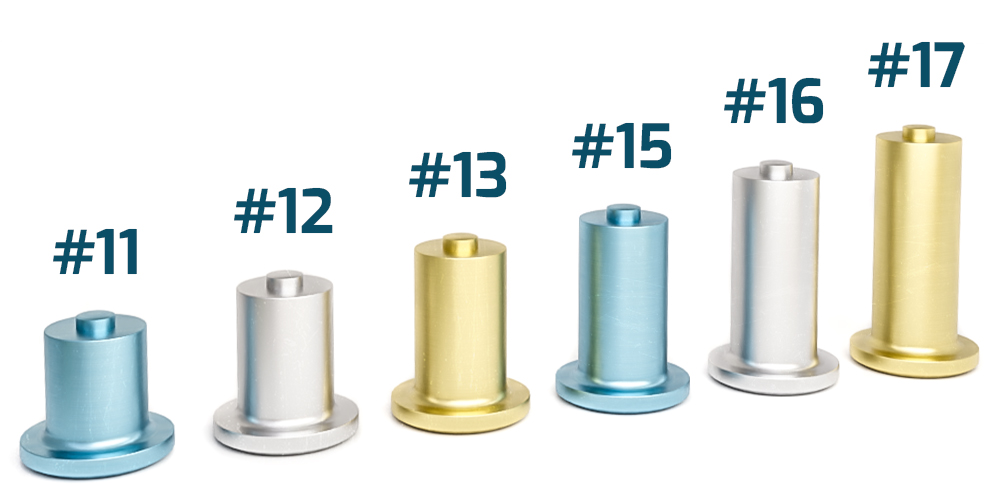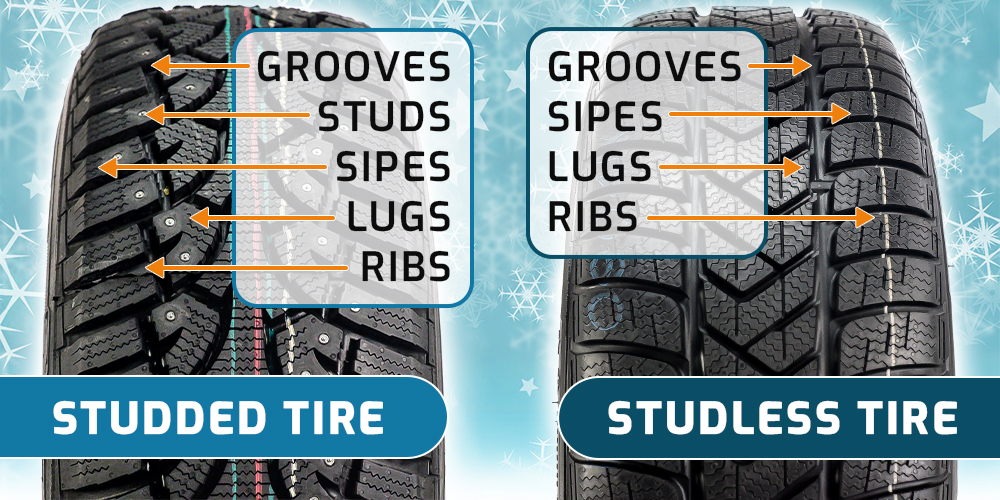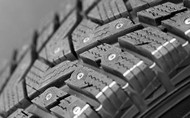Find Out What Are Studded Tires and Why You Should Use Them
Posted by Agota Szabo on Dec 29th 2022
Studded tires are a crucial part of tire history. Snow tire studs have been a hot topic for a while. They are definitely crucial for the tire's secure performance when demanding weather conditions rule. But, are these ice traction tires really worth it?
Stud tires, their use, and even state regulations will be discussed today. Keep reading and learn everything you need to know about these winter tires.
What Are Studded Tires?
Studded tires are winter tires that feature small hard rubber or metal bulges. Studs on tires are designed to increase winter traction by generating additional biting edges.
This is due to the extra traction winter tires with studs offer. Studs clawing into the ice- and snow-covered road, thanks to the added weight of the vehicle, optimize traction even on slippery surfaces.
Tire studs for snow and ice cannot be removed from the tread area, as that can damage the tire.

What Are Tire Studs?
Tire technology has come a long way, which is prominent in winter car tire improvements. Hard rubber and metal studs were designed to provide extra traction in winter conditions.
But, what are studded tires and tire studs?
Well, we have already described stud tires above.
As for tire studs, they are the small protrusions that you insert into the tread area. Hard rubber and metal stud tires offer extra biting edges to conquer different winter roads.
What Are Studdable Tires?
Studdable snow tires are the golden middle path between studless winter tires and studded tires. This is thanks to the pinned footprint, which sports predrilled tread holes where studs can be added or removed.
Inserting up to 120 studs/tire is a lengthy process. Whether drivers do it themselves or take the vehicle to a mechanic, it can become expensive. Additionally, varying tread depth tires require different types of studs.
See below the metal studs size chart:


Studded Tires Are Built Different
There is a specific time and place where studded tires can be safely used. This is not dependent on stud types, as all spike tires can easily damage road surfaces.
It is a truth universally acknowledged that a tire without good traction has less chance of performing well in winter conditions. This is where winter stud tires come into play.
Both hard rubber and metal studs provide extra traction on ice- and snow-covered roads. However, this does not mean that snow studded tires are able to perform throughout the winter months.
They have a limitation when it comes to their use. Studded tires work excellently on unplowed roads and off-road terrains. Their snow treads and studs work together to generate traction. However, this same traction can also easily damage roads when no ice or snow is present.
Studded Tires Pros and Cons
Like all winter tires, stud tires also come with their pros and cons. In order to strengthen a necessary characteristic, they must sacrifice the vitality of another.
Let's take a look at how studded tires work on plowed and unplowed surfaces, as it correlates to the advantages and disadvantages they provide.
Advantages of Studded Tires
Studded snow tires are designed to firmly grip snow and ice. This added grip gives them better traction compared to studless winter tires. Therefore, studded winter tires offer a safer ride on icy mountain passages.
A good studded tire set will provide the vehicle with secure off-road traction as well. Compared to studless winter tires, they offer stronger traction on uneven and versatile unpaved driving surfaces.
These studded tire advantages are ensured by their combination of the soft winter compound and the studs offering traction. The compound keeps the tire pliable, while the studs dig into the road to create traction. This improves acceleration, cornering, and braking on ice and packed snow terrains.
Disadvantages of Studded Tires
When it comes to the following performance characteristics, studless snow tires are better.
While studded tires perform well on ice- and snow-covered surfaces, the same cannot be said for clean roads. Whether you need dry or wet traction, a simple studless snow tire tread will perform better as its surface contact is not obstructed by studs. Their hydroplaning resistance is in the same boat - not that great.
Their diminished plowed road traction is their biggest drawback, but studded tires are also noisy. That is to be expected, as these tires with metal studs generate excessive road noise.
Studded snow tires cost a pretty penny. They are expensive! If you are not specifically in need of studded tires, in most cases regular studless winter tires will work fine. It will also be more budget-friendly.
Ice studs for tires dig into the driving surface. When there is not a layer of ice covering the road, those studs will claw at the paved road, damaging it. For this reason, their use is regulated by studded snow tires laws by state legislation.
How Do Studless Winter Tires Differ From Studded Tires?
All winter tires are designed for stronger traction in winter weather, ice, and snow conditions. This is true for both studded and studless winter car tires.
However, there is a major difference between the two types of winter models, which determines how and when they can be used. Studless tires do not feature the metal or hard rubber studs of their studded brothers.
Yes, that is the difference that changes everything. Both winter tire types sport wide grooves, a detailed siping placement, and optimally placed lugs on their often directional or asymmetric tread designs. But, studded tires feature studs.

Can You Use Tire Studs on All Winter Tires?
No, only studdable tires can have studs installed to their footprint. These winter tires are pinned for studs during the manufacturing process. The small holes located around the tread area are designed to hold studs. Do not attempt to stud a studless tire, as it will damage the tire's structural integrity.
What Is Tire Studding?
Tire studding is the process of inserting studs into studdable winter tires. While we would recommend getting professional help, studding tires can be done at home with a tire studding kit.
A stud gun and correctly sized studs are necessary. This is to make sure the tire is not damaged in the process. The studs need to be inserted into the predetermined holes located on the tire's footprint.
Tire Stud Insertion
Winter tire studs installed correctly will not cause issues. For this reason, it is crucial that studs are not added to the tread too shallow or too deep. Let us explain why these scenarios are not ideal.
- Tire Pins Correctly Inserted - When studs are correctly inserted, only their pinhole (molded hole) will go past the tread once the studding tool is removed. The tread will keep the studs stable and in place.
- Tire Screws Inserted Too Deep - If studs are inserted too deeply (or short studs are used), they will not provide the traction they need. That is, not until the tread wears away.
- Tire Studs Inserted Too Shallow - When too long studs are used or they are not inserted deep enough, the studs will move around and wiggle during the drive. This can cause the studs to come loose and fall out of the tire, or they can enlarge the pinhole and damage the tread area.

Additionally, studs should not be added at an angle. Less than 10 degree difference is still acceptable, but anything more than that needs to be taken out and restudded.

Are Studded Tires Worth It?
Whether spike tires for snow and ice are worth it varies between individual situations. Sometimes, studs help to ensure the vehicle's consistent traction on difficult surfaces. Still, often purchasing good snow tires without studs is a better decision.
But, how can winter tread tires differ so much?
Here's the thing - a snow, studded tire set is a good investment if you use it well. For drivers having to drive through mountain passes and on off-road surfaces, purchasing studded tires will be worth it.
However, if you live and drive in areas where only light winter conditions rule, you will have no use for studs. They might even be illegal where you live.
Are Studded Tires Legal?
You might as "why are studded tires illegal?" when you read this section. Trust us, there are great reasons behind these decisions.
Stud tires offer limited traction in dry and wet conditions. Basically, whenever roads are not covered by ice and snow, their acceleration and braking suffer. On the other hand, studs for snow tires can easily damage the road surface.
Therefore, state law regulates the use of stud tires.
States Where Studded Tires Are Banned All Year-Round
Some states have completely banned the use of studded tires on their roads. To be fair, most of these are Southern states, where the winter months are not as severe.
Without further ado, the states that do not allow stud tires under any conditions are:
- Florida
- Louisiana
- Michigan
- Mississippi
- Puerto Rico
- Texas
States Where Studded Tire Use Is Always Allowed
There are two types of states that allow the use of stud tires: those that have no restrictions and those that specify when and where studded tires can be used.
The states that allow stud tires are:
- Colorado
- Kentucky
- New Hampshire
- North Carolina
- Vermont
- Wyoming
The rest of the states (the ones not on either of these lists) utilize laws to restrict the use of such winter tires. Most of them only specify the dates when studded tires are allowed on the road. However, often roads and vehicle types are also specified in detail.
So, when do stud tires need to come off? Whenever the law says so!
Frequently Asked Questions
When Can You Put Studded Tires On?
State law governs when to put on snow tires with studs as such spiked tires can easily damage roads. By regulating their use, states minimize the possibility of road damage. Studded tire laws by state allow or deem the use of such tires illegal. Yet, it greatly differs from state to state.
How Long Do Studded Tires Last?
Average winter tires last about 3-4 months. However, stud tires with spikes experience a quickened tread wear along their footprints. Using snow studs for tires comes at the price of accelerating treadwear rate and shortening its service life.
How Fast Can You Drive With Studded Tires?
Most stud tires provide the same speed and durability as other types of snow tires. In other words, they offer safety up to 100 mph. However, when performing on ice- and snow-covered road surfaces, these studded car tires should not be driven at more than 40 mph.
Can You Put Chains on Studded Tires?
Yes, you can put tire chains on studded tires. In fact, when chains are required on your vehicle, drivers must install them even if they have these tires mounted on their vehicles. No matter what winter tires you have, chains must be used to satisfy state chain requirements.
















